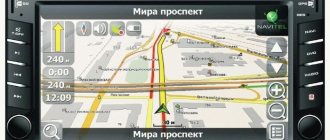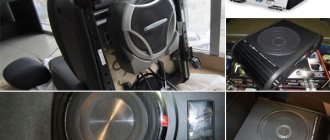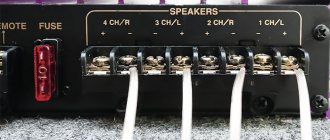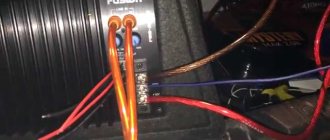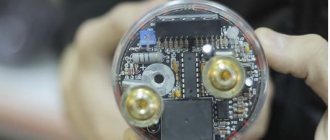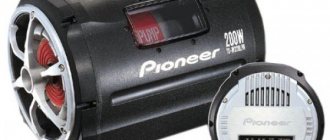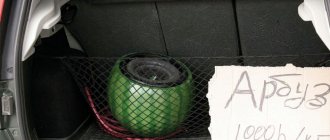To properly connect a subwoofer in a car, you need to solve several problems. First, the choice of low-frequency channel power is determined. If the car owner expects a comfortable sound picture in the cabin, then the output power of the system should not exceed 80-100 watts. In this case, the speaker can be placed on the shelf behind the back of the rear seat. With a higher output power, to obtain maximum sound pressure, the low-frequency speaker is placed in the luggage compartment of the car. Connecting an active subwoofer to a car includes supplying power to the built-in low-frequency amplifier and connecting the input terminals to the radio.
Passive and active subwoofer: differences and features
You have decided to install a full-fledged sound system in your car. The first question that you have to decide before purchasing is the choice between a passive and active subwoofer. Let's give a small educational program.
The passive subwoofer has a simple design. This is a housing and one speaker or several low-frequency audio heads. It is advisable to connect such a sub through an amplifier .
There are two ways to install a subwoofer in a car audio system without an amplifier: directly or with a crossover filter. The second allows you to get a cleaner sound, without distortion. Using this method, many save money, but such a connection does not provide good sound and can lead to a short circuit and failure of the radio, speakers or subwoofer.
An active subwoofer is a combination of several devices in one housing. Its design includes:
- audio amplifier;
- frequency divider;
- LF heads.
The housing contains linear inputs and outputs, audio power controls and frequency dividers.
An active sub is easier to set up. Using standard settings you get good bass. A passive subwoofer requires an external amplifier. Setting up a passive subwoofer is painstaking work. But the result will exceed all expectations. True music lovers achieve the best sound with passive subwoofers. Active costs 2-3 times more than passive. But the latter only works well with an amplifier that is purchased separately. As a result, we get approximately the same amount of costs.
Connection diagrams
The process of connecting a subwoofer and speakers in a car rarely causes difficulties. The recommendations described below will help you install and connect correctly.
Passive
It is recommended to connect the passive low frequency through an audio amplifier . It has connectors for connecting a subwoofer. For switching, special acoustic wires are used. They come complete with a subwoofer. If they are not available, then we buy the required length in a specialized store or at the radio market. The ends must have RCA connectors (tulip type).
In the absence of an amplifier, a passive subwoofer is connected to the front speakers. The sound will become more voluminous, but it is difficult to call it quality. A low-pass filter will help correct the situation. Through it, sound is sent to a passive subwoofer. The purpose of the filter is to suppress the high-frequency component of the sound signal and feed only the bass to the subwoofer. This device is sold in stores. But if you have the skills and ability to hold a soldering iron in your hands, then it’s not difficult to assemble the filter yourself. Schematic diagrams of the device are available in specialized literature and on the Internet.
This is interesting: Types of carburetors
The signal from the standard radio goes to the amplifier, and from it is distributed to the speakers and subwoofer
Active
An active subwoofer does not require the use of an amplifier. Its body contains an additional module for sound amplification and frequency controls for fine tuning.
Modern car radios have a linear output for connecting a subwoofer. It is connected to the input of the active subwoofer using an speaker cable. Another wire is designed to control the subwoofer. It is designated as REM or System Remote Control. The cross-section of the control wire is not critical; a weak current flows through it.
The active subwoofer is connected directly to the standard radio. Power to the subwoofer falls from the car battery
A power cable from the battery is laid separately to power the active subwoofer. Be sure to install a fuse in the power supply circuit of the amplifier and active subwoofer. It protects the speaker system from short circuits.
How to calculate the required audio system power
A preliminary calculation of the power of the audio system will help you choose the right power cable and other necessary components. Here you will need to know the exact rated power of the installed amplifiers. The parameters can be found on the Internet for a specific amplifier model or in the instructions for the device. If a separate speaker amplifier is integrated, its power should also be taken into account.
The indicators should be added together, thus obtaining the power of the system. The power wire will need to be selected taking into account the obtained value. If a motorist plans to install higher-power speakers in the future, it is better to immediately select a cable with a reserve.
Connecting the sub: important points and instructions
Let's look at the process of installing a subwoofer in a car with a connection to the standard radio. Before starting work, pay attention to a few points:
- The subwoofer housing and the amplifier itself are large devices. We need to think about where to place them. Most often, a place is allocated for them in the luggage compartment of a car.
If possible, the amplifier is placed on the back of the rear sofa. Remember that the amplifier and active subwoofer become hot during operation. These devices require good cooling. Position the amplifier and sub so that air can circulate freely around the devices.
- If the standard head unit does not have outputs for connecting a subwoofer and there is no control wire, then think about replacing the radio. This will protect you from possible short circuits, simplify connecting the subwoofer and allow you to get high-quality sound. An active woofer requires battery power. The power cable must be of appropriate length and cross-section. Consider where to route it from the engine compartment to the luggage compartment. It must be firmly fixed with plastic clamps.
- Check the presence of a line output for the subwoofer on the standard radio. If not, there is a way out. The subwoofer is connected to speakers or AUX output. This solution is not ideal and affects the quality of sound reproduction.
- To control the active subwoofer, a System Remote Control wire is required. Without it, the amplifier module does not work. If the radio does not have such an output, then you can directly supply constant +12 volts to the input of the active subwoofer. With this connection, the amplifier operates continuously and discharges the battery.
Required tools and materials
To successfully connect a subwoofer with your own hands, prepare the following tools and materials:
- wire cutters;
- knife;
- set of open-end wrenches;
- insulating tape;
- pliers;
- plastic ties;
- power cable;
- speaker cables;
- 60A fuse in the housing;
- plastic pullers for dismantling trim elements.
The length of the wire for powering the subwoofer and speaker cable depends on the specific car model and the possibility of laying the wiring under the trim. The cross-section of the power cable depends on the power of the active subwoofer or amplifier. For example, the power of a subwoofer is 200 watts, divided by 12 (the voltage in the electrical circuit of the car), we get 16.7 amperes. The power cable must withstand this current and not overheat. Based on this, the wire cross-section is selected.
This is interesting: About xenon headlights
Step-by-step instructions for installing an active subwoofer
- Turn off the power to the car and remove the terminals from the battery.
- Route the power cable from the battery to the subwoofer installation location. The wire should not get under the pedals or interfere with the operation of other mechanisms .
- Install a fuse on the wire near the battery. Do not connect the power cable to the battery terminal.
The subwoofer is powered by a rechargeable battery. Be sure to use a fuse to avoid wiring troubles - Remove the original radio and inspect the rear panel. Locate the line output for the subwoofer and the control wire.
Find the linear output for the subwoofer and the control wire - Route the speaker cables and REM (System Remote Control) wire from the radio to the subwoofer location. Place the wires under the trim elements and secure them securely with plastic clamps.
All wiring is laid under the trim elements of the car interior. It is securely fastened with plastic clamps - Connect the control wire, speaker cable, power and ground wires to the subwoofer. Take the “earth” from the metal surface of the car body.
- Connect the sub and REM wire to the radio. Carefully insulate the twisted areas. Install the radio in its original location.
- Connect the power cable to the “+” terminal of the battery.
How to Connect a Subwoofer Speaker to an Amplifier
The subwoofer speaker is connected to the amplifier using an acoustic cable, which is included in ready-made kits or purchased separately. It is best when the ULF and subwoofer are located nearby. This allows you to reduce the length of connecting wires to a minimum. This reduces cable losses. If the low-frequency module and subwoofer are located in the luggage compartment of the car, a storage capacitor is attached nearby, which will avoid sound dips at high power. When laying connecting cables inside vehicle compartments, you must use the existing technological holes. At the points of transition through metal surfaces, plastic bushings are placed on the wires to avoid damage to the insulation and short circuits.
Installation nuances in cars of different brands
The subwoofer and amplifier are placed in the luggage compartment in 99% of cases. But the trunk does not always have sufficient volume. For example, in a VAZ 2114 it is problematic to place a passive subwoofer and amplifier and leave room for transporting something. Therefore, for 2114 it is better to choose an active subwoofer with a suitable housing. Fortunately, car audio stores offer a wide selection of models of different power and configurations.
Take the installation of the power cable seriously. Look for a way to route the power wire through the factory holes. Use rubber or plastic couplings to move from the engine compartment to the luggage compartment. The wire should not come into contact with metal. This will help protect it from chafing and possible short circuits.
For the power cable, it is recommended to use plastic or rubber couplings for transition from the engine compartment to the passenger compartment and from the passenger compartment to the luggage compartment
Self-installation and connection of the subwoofer will take from 1.5 to 3 hours. The procedure is simple, but requires care and precision. If you have doubts about your abilities, contact specialists installing speaker systems. They will select the speaker components and connect them. And after 2-3 hours you will be able to enjoy high-quality surround sound in your car.
Let's get acquainted, my name is Dmitry Kuznetsov. (8 votes, average: 4.5 out of 5)
Do-it-yourself subwoofer placement in the car interior
The sound quality depends on the placement of the speakers. However, there is too little space in the car to space them out properly. In addition, the characteristics of the propagation of low-frequency sound waves have an effect.
At a sound frequency of 100 Hz, the wavelength exceeds 3 meters, at 50 Hz - twice as much. Thus, the lengths of low-frequency sound waves are comparable and even exceed the dimensions of the cabin.
“Sound wavelength (L) is the distance between two adjacent vibrations in the same phase. Frequency (F) - the number of oscillations per unit time. Both parameters are related to each other through the speed of sound C, which (m/s) is equal to the product of frequency (Hz) and wavelength (m). Considering that the speed of sound in air is 343 m/s, you can always calculate the value of the wavelength, knowing the frequency, just as you can calculate the frequency from the wavelength.”
Under such conditions, the waves do not propagate in the usual sense of the term; vibrations of the speaker diffuser are perceived as pushes of a piston, alternately increasing or decreasing the air pressure in the cabin.
We perceive the direction of sound by analyzing the time difference between the wave reaching the left and right ears. And since there is no propagation, then the direction to the sound source cannot be determined.
This means that the location of the subwoofer in the car has virtually no effect on the sound quality. When choosing a suitable location for a low-frequency cabinet speaker, first of all take into account:
- ease of access,
- costs and effort for installation,
- interference with the intended use of the vehicle.
In the vast majority of cases, the subwoofer is placed in the trunk. Most popular places:
- behind the back of the rear seat with a diffuser in the trunk,
- in the wing niche (stealth subwoofers),
- in the rear parcel shelf there is a diffuser into the salon,
- behind the folding armrest there is a diffuser in the salon,
- in the floor
- in the spare wheel well.
Gallery: installation examples
Placing a cabinet subwoofer in the armrest niche
Placing a cabinet subwoofer in the center of the trunk with the diffuser facing outward
Placement of the stealth subwoofer in the rear fender niche
Placing the subwoofer in the trunk floor
There is an excellent acoustic connection between the interior of a hatchback or station wagon and the trunk. In these bodies, the subwoofer can be installed in any of the places listed above.
In sedans, the trunk is better insulated, which can reduce the sound pressure in the cabin. To prevent this from happening, it may be necessary to cut additional holes to improve the acoustic connection. Their total area must be no less than the diffuser area.
In the rear shelf and in the armrest, subwoofers are installed, firstly, in such a way that there are no obstacles in front of the diffuser. Secondly, there are no gaps between the speaker body and the shelf (seats).
The natural place to place small powered subwoofers in a flat enclosure is under the seat. These devices perform best in small-class cars, where the miniature dimensions of the interior help “build up” the sound pressure.
Placing a flat subwoofer in a car under the seat


